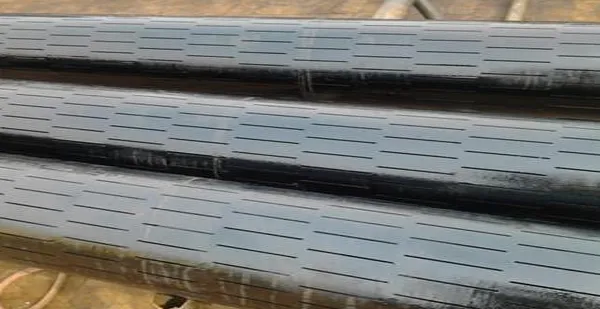What is a Slotted Casing Pipe?
Slotted casing pipe fittings are a type of pipe assembly commonly used for oil and water well completions. They have a series of elongated slots used to control formation penetration and prevent impurities such as sand and gravel from entering the wellbore, while allowing target substances such as oil and water to pass through. Its manufacturing technology and craftsmanship are crucial to ensuring the quality and performance of the pipeline. The following will introduce the manufacturing technology and process of slotted casing pipe fittings in detail. At the same time, its characteristics, uses, construction methods, advantages and disadvantages, etc. are introduced in detail.

Manufacturing process of slotted casing
1. Material Selection
The foundation of a high-quality slotted pipe lies in the selection of appropriate materials. Common choices include:
Carbon Steel: Known for its strength and durability, making it suitable for demanding environments.
Alloy Steel: Offers enhanced mechanical properties and resistance to corrosion.
PVC (Polyvinyl Chloride): Lightweight, corrosion-resistant, and ideal for applications requiring flexibility and chemical resistance.
HDPE (High-Density Polyethylene): Extremely tough with excellent chemical resistance, suitable for transporting potable water, wastewater, and chemicals.The choice of material depends on factors such as the intended application, environmental conditions, and required mechanical properties.
2. Pipe Formation
Once the material is selected, the next step involves forming the base pipe:
For Metals: Steel sheets are rolled into cylindrical shapes and welded to form seamless pipes.
For Plastics: Materials like PVC or HDPE are extruded into pipe forms, ensuring uniform wall thickness and diameter.
3. Slotting Process
The defining feature of slotted pipes is the precision slots that allow fluid passage while filtering debris. The slotting process includes:
Design Specifications: Determining slot size, shape, spacing, and pattern based on application requirements.
Slotting Techniques:
Laser Cutting: Utilizes focused laser beams to create precise slots with minimal thermal distortion. This method ensures high accuracy and smooth edges.
Mechanical Slotting: Involves using automated slotting machines equipped with programmable logic controllers (PLCs) to achieve consistent and accurate slot patterns.
Common slot types include:
Straight Slots: Cut at a right angle to the pipe wall, maintaining uniform width throughout. While cost-effective, they are less effective in sandy environments.
Keystone (Tapered) Slots: Wider on the inside than the outside, reducing the risk of clogging by allowing particles to pass through more easily.
Slot patterns can vary, with common configurations being:
Line (Straight) Pattern: Slots aligned in straight lines along the pipe length.
Single-Slot Staggered Pattern: Slots are staggered in adjacent rows, enhancing structural integrity and flow distribution.
Gang (Multiple Staggered) Pattern: Features multiple slots at each position in a staggered arrangement, providing higher open area and strength.
4. Surface Treatment
Post-slotting, pipes undergo surface treatments to enhance durability and performance:
Cleaning: Removing debris, oils, and residues from the slotting process to ensure a clean surface.
Corrosion Protection:
Coating: Applying anti-corrosive paints or coatings to protect against environmental factors.
Galvanizing: Hot-dip galvanizing provides a zinc coating, offering robust protection against corrosion, especially in harsh environments.
5. Quality Assurance
Quality control is an essential part of the production process. Each slotted pipe undergoes strict inspections to ensure it meets industry standards and customer specifications. Tests are conducted to verify slot dimensions, structural integrity, and pressure resistance. Any defects detected during these checks are addressed before the pipes are approved for use.
For longer or customized slotted pipes, sections may be joined through precision welding. This process ensures seamless slot continuity while maintaining mechanical strength. Post-weld heat treatments may also be applied to relieve stress and enhance durability. Proper welding techniques are critical in preventing structural weaknesses and ensuring long-term performance.
6.Packing and Delivery
Once inspected, slotted pipes are packed securely to prevent damage during transportation. Standard methods include bundling with steel strips, wrapping with protective covers, or using wooden crates for sensitive materials.
The production of slotted pipes is a meticulous process that demands precision at every stage—from material selection to final inspection. Adherence to stringent manufacturing protocols ensures that the pipes perform optimally in their intended applications, offering durability, efficiency, and reliability.
How to Select Quality Slotted Casing Pipes
When choosing slotted casing pipes, consider factors like slot dimensions, material compatibility, anti-corrosion treatment, and compliance with API 5CT standards. Consulting with reputable manufacturers ensures access to high-quality products tailored to specific project needs.
To sum up, slotted casing, as an important pipeline structure in oil and water well completions, has many functions and functions, such as controlling formation penetration, preventing impurities from entering, and filtering oil and water. It is widely used in oil field mining, water conservancy engineering, environmental engineering and other fields. It is an important component to ensure the stable operation of the wellbore and improve production efficiency.
Call to Action
Looking for premium-quality slotted casing pipes for your next project? Contact Baowi steel today to explore our wide range of API 5CT-certified products designed for optimal performance in challenging environments.






 English
English Español
Español بالعربية
بالعربية











 Phone :
Phone :  Whatsapp :
Whatsapp :  Email :
Email : 


